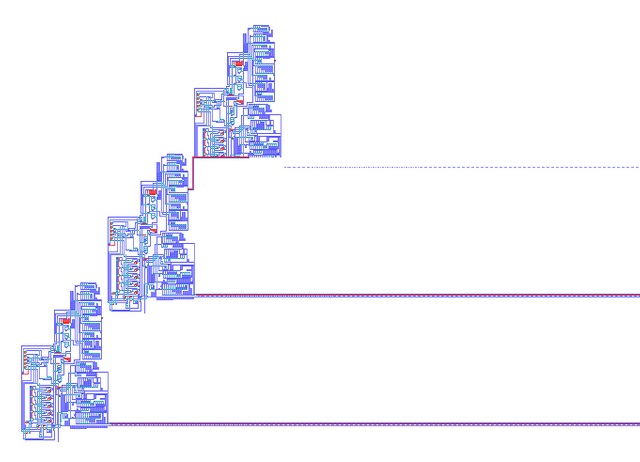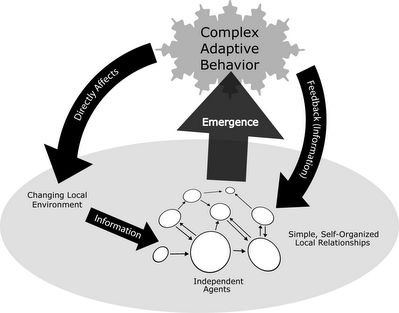Universal Darwinism and Cyberspace
Universal Darwinism and Cyberspace
What is Universal Darwinism?
Universal Darwinism is about the evolution of information patterns. Typically when people think about Darwinism they think about it from the perspective of biological evolution but it is important to note that evolution appears to take place on a universal level beyond merely biological.
Cellular automata shows how emergence can work. In Conway's Game of Life we can see how an information pattern can emerge and evolve into something which resembles artificial life. By understanding cellular automata we can better understand how cryptocurrencies, blockchains, and datastructures in cyberspace can be seen as different species which evolve. DACs, DAOs, blockchains, smart contracts, are all describing something which is at a fundamental level just an autonomous agent.
How does Universal Darwinism evolve cryptospace?

Witness that if the universe itself may be a computer then cyberspace may also be a computer. Cryptospace in a state of universal Darwinism would evolve through the mechanism of the market which simulates natural selection. The market itself could be considered merely a means to an end for the evolutionary engine of cryptospace. Natural computation can be witnessed by looking at the human brain which clearly allows for computation. At the same time there are non-biological sources of computation as well which would fall under the pancomputationist worldview.
In cryptospace we have different entities which we could call information patterns which take the form of algorithms, data structures, autonomous agents, and at the foundation of these are the complex adaptive systems. The data structures are blockchains, distributed hash tables, directed acyclic graphs, and more. None of these data structures are sacred, but are merely just structures for data, which can act as databases, ledgers, storage whether permanent or transient, and more. Algorithms make up what I could describe as the recipes, and many recipes are very common. Algorithms can be discovered by studying the environment, as they are everywhere in nature. Autonomous agents, intelligent agents, these are the self interested entities within a complex adaptive system.
Cryptospace as a complex adaptive system

To be simple, an autonomous agent perceives it's environment, processes information from it's environment, and acts based on that information. A human being, a robot, a smart contract, a digital assistant, all would be autonomous agents. The complex adaptive system represents the community itself, as a whole, with all of the pieces together complete with feedback loops. While an individual robot or a human could be defined under the phrase "adaptive system", the complex adaptive system is the whole system.

An adaptive system is a self adjusting, and a complex adaptive system is the macro to the adaptive system micro. Are we a blockchain of code or are we a blockchain of adaptive systems? If we are a blockchain of adaptive systems then the foundation of a blockchain and of all cryptospace on the macroscale is a complex adaptive system. This complex adaptive system can evolve in response to threats in it's environment and the process for doing this is what Amanda Johnson calls "currency competition" which is a neologism for universal Darwinism.
Currency competition as a means to Darwinian evolution of cryptospace

Currency competition is how cryptospace and technology within it can evolve to fitness. The means of this evolution is a process of selection where the users select which currencies survive or die by their uses patterns. This is one reason why I favor forks and do not believe in the concept of blockchain maximalism. The ability to always leave an obsolete chain for a better chain is fundamental for the evolability of cryptospace itself which only can evolve through a market enabled Darwinian process. At the same time I think this process should be taken much further, by utilizing reputation systems which allow users to rate every aspect, including the designs, first by community reviewing the white paper, the formal specification, the implementation, according to community determined metrics which consider aspects such as profitability but also which satisfy ideological concerns for people who shop based on that.
Cyberfund is one of the first examples of this sort of ratings based approach. It utilizes metrics and promotes currency competition. In my opinion it is that example which can become a model for an even more detailed approach in the future where the quality standard is continuously raised. I'll discuss more on this topic will be in a future article.
Unlimited pancomputationalism (computers are everywhere!)
Unlimited pancomputationalism will be explored further in future articles but it is very relevant to understanding universal Darwinism. Universal Darwinism is a kind of computation that takes place on the universal computer where a generate and test trial and error approach is taken to approximate a selection patter solution and propagate it. Information is what is at the foundation, whether we speak of memes, or genes, or the radiation that escapes from the event horizon of a black hole.
What are some biological sources of computation?
These fantastical ideas about computation may not be believed so I'll start with a biological example. Many people know what a digital signal processor is. DSPs can filter out unwanted noise from a signal. The Nyquist–Shannon sampling theorem is the bridge between analog signals and digital signals which allows for the DSP to process signals. The work of Claude Shannon makes up the foundation of the digital revolution, information theory, and even digital physics.
Many people might not be aware that Japanese tree frogs are using a mating call algorithm. This mating call algorithm uses the process of desynchronization to allow female frogs to single out specific male frogs who may be in close proximity. This algorithm is a good example of a natural social computation that the frogs do because their genetics have evolved them to do it but which has practical utility for wireless networks trying to avoid frequency overlap. Many other biological computation examples exist such as behavior seen in ants, bees, or flocks of birds, all which utilize swarm intelligence.
What are some of the non-biological sources of computation?
There are two main ways to think about computation. Abstract computation or concrete computation. Concrete computation would include the computation which takes place by silicon or in the brain. The concrete computations are familiar to computer scientists while abstract computation is under deep investigation, discovery, and discussion. Non-biological sources of computation could be either concrete based on physical systems such as in the case of a Turing machine and in the case of digital on a silicon chip or it can be abstract which is a theoretical model of a computer such as what cellular automata uses.
To be continued
This article is really just an introduction to the topic of universal Darwinism, the evolution of cryptospace, pancomputationalism, and other concepts. Some of these concepts are very abstracted and heavily debated among researchers as to their validity. The purpose here is to simply start the conversation on the topic of evolvability of cryptospace and to show that the market is the means to an end rather than the end in itself. The market is important because it allows the complex adaptive system to evolve, which includes humans, robots, code, etc. To put the code first or to put the human first is to miss the fact that the human and code are in a feedback loop inside of a complex adaptive system. The code and humans have to co-evolve and for this reason human beings need to seek the most profitable DAOs, DACs, DCOs, the most technically beautiful code, algorithms, proofs, designs, as it is our job to be the ultimate curator of value in cryptospace.
References
- https://arxiv.org/pdf/1001.0068.pdf
- http://plato.stanford.edu/entries/computation-physicalsystems/#AbsComConCom
- http://www.mdpi.com/2078-2489/2/3/460/htm
- Dodig Crnkovic, G. (2012). Physical computation as dynamics of form that glues everything together. Information, 3(2), 204-218.
- Hernández, H., & Blum, C. (2012). Distributed graph coloring: an approach based on the calling behavior of Japanese tree frogs. Swarm Intelligence, 6(2), 117-150.
- https://en.wikipedia.org/wiki/Adaptive_system
- https://soundcloud.com/bitcoinuncensored/amanda-b-johnston-talks-to-chris-derose-and-junseth-about-bitcoins-problems-dashs-solutions
- https://en.wikipedia.org/wiki/Digital_physics
- http://philpapers.org/browse/pancomputationalism
- http://seop.illc.uva.nl/entries/computation-physicalsystems/
- https://en.wikipedia.org/wiki/Abstract_machine
- Piccinini, G. (2015). Physical computation: A mechanistic account. OUP Oxford.
- Whyman, R. (2016). Physical Computation, P/poly and P/log. arXiv preprint arXiv:1606.06803.
- Zheng, H., & Song, F. (2012). Physical Computation Theory. Journal of Wuhan University(Natural Science Edition), 58(1), 73-80.
- https://arxiv.org/abs/1309.7979
- http://philosophyofbrains.com/2015/08/10/is-computation-abstract-or-concrete.aspx
Most of the models of the crypto-space seem to assume a "winner-takes-all" mentality. I think that we will see an ecosystem evolve, with different currencies and systems occupying different niches.
I love to think of cryptocurrency as a digital animal dropped onto a pile of "valuable" paper. It evolves to eat paper. Cryptos are of course competing not only with fiat but eachother too. It's definitely wise to invest with longevity, usefulness, speed, defense (security), and fertility in mind.
Do you think the first organism to work out duplication is still around? Probably not. But... it was a delicious food source for more powerful organisms. I think that's the future of Bitcoin and cryptos. The ecosystem is still nascent and searching for balance hopefully we can pick out functional coins and achieve stability sooner.
Bitshares, monero, sia or maidsafe, lisk or etherial etherium.